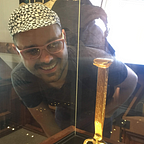“In accord, in a daze”: Reflections on Making and Mastery in Joanna Newsom’s Make Hay
Part 3 of 3
We’ve accumulated a bit of time and passed a few days now since Part 1 and Part 2 of our exploration into “Make Hay” began (read them here and here if you haven’t yet!). The Californian singer/harpist has shown an amazing command of language in shaping the song. I’m often reminded of the lines from Wallace Stevens’ poem:
She was the single artificer of the world
In which she sang. And when she sang, the sea,
Whatever self it had, became the self
That was her song, for she was the maker.
Joanna Newsom creates universes — she tells stories. To some extent I think a lot of what we’ve looked at so far is backdrop, thematic context, for a more human tale. I’m still left with questions. Who is this “she”? Why does her death matter? What was so remarkable about her life?
We can start to put pieces together here and there. We know the narrator sees her as an “old friend”, whether that means they were friends for a long time, or that she was old, or both. It seemed that she lived a rugged life in a rural setting, probably out West given the reference to goldmines and the iconic circling vultures.
Though she dug in her heels
Drug her wheels in the clay —
She dotted her eyes;
Crossed the teasels in her leaning dray
Where buzzards make circles
(And tillers make hay)
What do we make of these dots and crosses? We looked at them in light of weapons and war, and in the sombre air of a deathbed, they certainly recall the coins on a corpse’s eyes and the clergyman’s sign of the cross. There is also the expression “dot your i’s and cross your t’s”, which implies that perhaps the dying woman had seen to her affairs and completed everything she needed to.
But there must be more to the story!
I’m drawn to the “leaning dray” and the “leaning sled”, both of which could be used to transport hay. Drayage, meanwhile, refers to the movement of goods in a port, between the ships and long-distance transportation. When the American West was still frontier country, those longer trips would have been made by mule or wagon, while more valuable cargo was transported by stagecoach.
In his book Roughing It, Mark Twain calculated the revenues of moving silver from Nevada to the coast:
“Two tons of silver bullion would be in the neighborhood of forty bars, and the freight on it over $1,000. Each coach always carried a deal of ordinary express matter beside, and also from fifteen to twenty passengers at from $25 to $30 a head. With six stages going all the time, Wells, Fargo and Co.’s Virginia City business was important and lucrative.”
With that much bullion moving around in coaches, the risk of being held up at gunpoint ran high. Highwaymen like the chivalrous poet Black Bart captured the fascination of the populace and stoked the ire of Wells Fargo.
Staring down the barrel of a raised gun, and finding themselves outnumbered, many coachmen would surrender their treasure box, and allow passengers to be looted. Others relied on armed guards, or took matters into their own hands, like one driver in a hold-up who “contemporaneously, turned his wild mustangs and his wicked revolver loose, and brought everything through safe.” The story continues:
That his shooting was to the mark was subsequently ascertained by the confession of “Sugarfoot,” a notorious highwayman, who, mortally wounded, found his way to a miner’s cabin in the hills, and in articulo mortis told how he had been shot by Charley Parkhurst, the famous driver, in a desperate attempt, with others, to stop his stage.
This fearless coach driver was known throughout gold country as “Cockeyed Charley”, because a horse had kicked out his left eye, which he then covered with a patch (dotted their eyes?). Charley first came to San Francisco to work in a drayage business, eventually gaining fame as a skilled coachman (leaning dray?). With the growth of train networks, he left the stage business and became a farmer.
Thinking back to Newsom’s interview in SF, she talked about the central, organizing question of Divers as “What’s the point? Why are we in one time…?” I find that second question particularly apt when applied to Charley:
How were they to know? It was only after her death that Charlotte’s friends discovered her camouflage. Perhaps she lived too early. Perhaps it was before her time. Or, perhaps — like Joan of Arc, Little Jo Monaghan, and many others over the centuries — time just wasn’t ready for her.
So, now that we’ve found her — the first woman to vote in California — like a spiral returning us to a familiar place with a fresh perspective, let’s listen once more to Newsom’s masterful work:
Thank you for reading!
In memoriam: K. K., who always made her own path.
